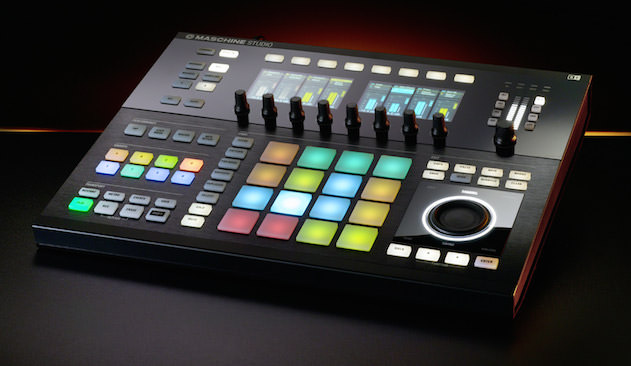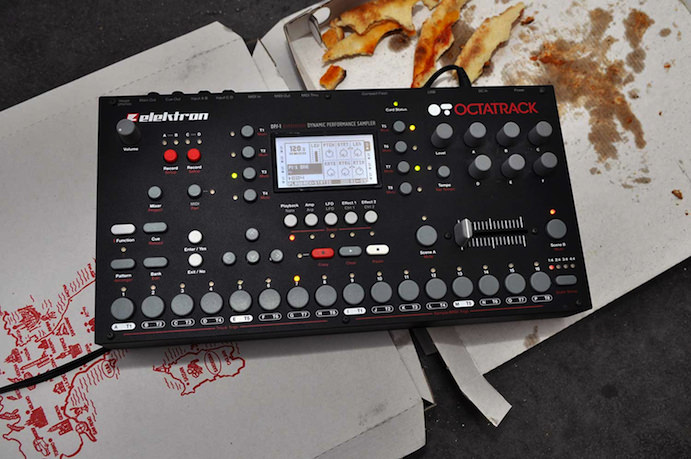Native Instruments Maschine
2009 – present

Fashions move in cycles, and the world of music technology is no exception. Given the current obsession with hardware you’d be forgiven for thinking it had always been this way, but following the great DAW revolution just after the turn of the millennium the trend was resolutely in the opposite direction, with hordes of producers rushing to do as much as possible in the box. Software brought with it a great number of advantages, not least in terms of making the technology more affordable and accessible to a wider audience, but in our rush to embrace the brave new world of software many of us realised we’d lost some of the major benefits of hardware: the ability to adjust multiple controls simultaneously, play instruments on pads and keys, or just to feel some physical feedback on our fingertips.
The last few years have seen a major swing back in the other direction. Generic MIDI controllers go some way to bringing back the hands-on control, but no matter how many hours you spend setting up mappings for your software you can only get so far with a generic hardware layout. The logical conclusion was reached in 2009 when Native Instruments launched a new hybrid product, Maschine. On the software side, Maschine is a fairly straightforward but very powerful sampler and sequencer, capable of running as a plugin in a DAW or as a standalone application in its own right. What sets it apart is the inclusion of a dedicated hardware controller designed for ultimate integration with the software package.
It’s just about the most obvious solution imaginable, but in practice Maschine is much more than the sum of its parts: the versatility and flexibility of software combined with the immediacy and hands-on control of hardware. With access to Native Instruments’ huge sample libraries, it’s hardly surprising that Maschine – now updated to version 2 and also available in Mikro and Studio versions – has had on the world of dance music production.
in practice Maschine is more than the sum of its parts
Maschine isn’t the only option in this category. Arturia’s Spark and Akai’s MPC Renaissance both offer alternative takes on the same overall concept, while Ableton’s Push can also cover a lot of similar ground. With so many great options available, the hybrid sampler looks set to stay. Why choose between hardware and software when you can have the best of both worlds?

06.26 PM
Pete Rock with CL Smooth’s Mecca and the Soul Brother is a masterpiece
06.45 PM
“Now let me take a trip down memory lane…”
Thanks guys. Really enjoyed this. Brought back some memories!! I definitely remember playing with a friend’s toy sampling keyboard when I was a kid… Might have been the Casio… I bet we weren’t the only ones recording burp and fart sounds into it!!
Anyway, slightly more serious… my experience from mid 90\s onwards was… back then it was ALL about the S1000, 2000 and maybe a handful of 3000s. People I knew were making house and techno mainly, a few getting more into drum and bass. I remember people looking down on the 900 and 950 for being a bit old fashioned… I guess because they were 12 bit
MPCs were strictly for the hiphop heads and I only really remember them from quite late in the 90s… the hiphop guys I knew were using Akais because they were easier to get hold of. As for the SP12 I don’t even remember seeing one until years later.
A few Emus around but nowhere near as much as Akais. Maybe because they were more expensive?
I ditched the hardware samplers as soon as computers were up to the job…
I sometimes consider a S900/950 but I’m not sure I’d go back to the hassle of chopping and editing samples in one… pretty much everything’s done with the Maschine now just cos it’s so easy. I got an MPC2k a couple of years ago to see what all the fuss was about. understnad the appeal but I think you’ve got to commit to the workflow. Too spoiled by ableton!
02.30 AM
I love the EMU’s and still use them. The E64 and E6400 have this sound that is unobtainable anywhere else. ASR10 is of course great. Im not a huge fan of the Akai’s. Thanks for the article and any other articles about samplers are greatly appreciated.
08.43 AM
Great article, proper gear lust watching those videos. Biggups.
04.08 PM
Funny how it goes, I remember dreaming if the day I could get s3000xl, a4000 or one of the emus.
Wouldn’t want one now mind, Zip drives n floppies!! Arghh.
02.24 AM
glad you guys used my videos!
04.27 PM
Re: Octatrack: “Artists as diverse as Alan Braxe, Mumdance and Zombie Nation have raved about it in interviews with us.” Call me lame but I’ve never heard of those three acts. I think this list would have been better off as Five instead of Nine. It’s way too much of a stretch to say that a three-year-old bug-ridden product like the Octatrack has defined much of anything except for Elektron’s reputation for notoriously terrible customer service.
08.03 PM
@Alex.
Um… Alan Braxe would be the co-writer of ‘Music Sounds Better With You’, one of the biggest crossover hits of recent times.
So yeah, LAME – assuming that’s fine?
(Not that I disagree with your wider point).
02.44 PM
I think it’s the Commodore Amiga and the Creative Lab’s Sound Blaster that really brought sampling to the masses. Suddenly kids could do advanced sampling tricks in their bedrooms. Stuff that could only be done in expensive studio’s before.
Dance music would not be the same if only rich and experienced musicians in fancy studio’s would be able to use sampling.
08.32 PM
I remember messing around on the Casio SK-1 (or definitely something similar) when I was younger; my sister gave me hers when she went off to college (ages ago!). I messed around with it trying to make music like off the Streets of Rage games on Sega, then got bored with it. Now, after all this time, I produce dance music; who knew!
08.43 PM
mpc 60 made my day there + sp1200 of course
10.46 PM
Top article! Can’t get enough of these machines and their stories.
More S series goodness: http://www.youtube.com/watch?v=2ACk3paLv_s
http://www.youtube.com/watch?v=FcDhCeuaAk8
http://www.youtube.com/watch?v=sfcx4qq6UVE
07.22 AM
Great article. The Akais in that shot look oddly familiar.
07.52 PM
alex-
you have the right company? elektron definitely doesn’t have a rep for bad customer service, in fact it’s quite the opposite.
there’s bugs in everything, but none that would keep you from creating on it. while i don’t personally use an octatrack, it’s easy to see why it belongs in this list… it does a lot of stuff that no other samplers can do, and it’s extremely functional for live sets or production.
04.40 AM
It was a great read, but the title is misleading. While Ableton undoubtedly has made a mark in a historical context, I don’t see how Kontakt, Maschine or the Octatrack can be referred as “Samplers that defined dance music.” Perhaps actively changing things, sure, but not in a historical context. As others have commented, what about the Ensoniq range (ASR, EPS…)? The Amiga? Korg’s offerrings?
06.56 PM
Thanks for the article, I will be the one who say it : wtf no emu Eii sampler ? It was used from italo disco hits to rock punk / new wave and of course early dance tracks. A big omission in this article unfortunately …
Thanks for the effort altough !
02.16 PM
Linn… Linn machines !!
09.25 PM
I can’t believe this list left out 2 of the best samplers released since 2006- the Kaoss Pad 3 and MicroSampler, both from Korg. I’ve been using those 2 pieces of equipment since 2012 and use both units in my live performances. The sampling capabilities of the 2 are THE best out there as far as standalone units & the resampling function on the KP3 is hard to beat- you can resample ENDLESSLY, layering your sounds veey dense! And don’t forget about the awesome effects it has as well! The MicroSampler may be limited with memory time (I think 8 mins mono and 4 minutes stereo all together- 8 banks so 2mins per bank with mono) but its Auto Next fuction lets users chop samples to various keys, like drum beats, a key for a kick, key for a snare, and so forth and allows the users to do so without having to pause whatever they’re sampling and set up to sample the next sound. You can sample down to 1/64th of a beat to get super precise stabs. AND it has a 99 beat pattern sequencer which users can store 16 patterns per bank! (16 x 8) Please include both of these pieces of gear in your next list of best samplers.
07.14 AM
I have to agree with some others, emu were easily as big as Akai, especially for people that wanted great sounding filters. I owned several emu’s, and still have one, and so did everyone I knew. I don’t think anyone I knew that was making dance music in the place I grew up used an akai, all of us had emus. . Also have to say something like audio engineer combined with one of the tracker programs for the Amiga should be in there, its how a lot of people made their way into dance music in the 90’s (before moving on to an e6400 or similar)
12.06 PM
Sp12 & SP1200 was used all the time in combo with the Akai 950 from the early 90s in Hip Hop nd House i.e. Pete rock Paul C Large professor D.I.T.C Master at Work Todd Terry the list goes on…. Simply a dope machine with only 10 sec to play with the only real limitations is your creativity.
04.25 PM
Kind of surprised the Ensoniq ASR-X didn’t make either this or the drum machine list. Great units that have their own character.
10.21 AM
@Alex
“it’s way too much of a stretch to say that a three-year-old bug-ridden product like the Octatrack has defined much of anything except for Elektron’s reputation for notoriously terrible customer service.”
Do you own one? Have you spent any time with it if you do own one?
Ive owned my OT since it was released and year on year, Elektron have continued to support and develop it. It has had numerous updates, and theyve always been great on the forums. The OT to me, is the single most creative and flexible piece of kit in my studio. Thats not to say it is easy to use – its probably the most punishingly difficult thing ive ever owned – but once you see it as an INSTRUMENT that needs commitment and learning, youll fall in love with it and see the limitations as positives.
12.53 AM
No NED Synclavier, for mi one of the most powerful sampler workstation of all time. Grat artist based mani records around it, like Frank Zappa, Tevor Horn and many more. And no Yamaha samplers, RMX1 or SU700.
05.12 PM
Rm1x is not a sampler 😀 RS7000 is.
12.31 AM
This list has no Ensoniqs which is hilarious
02.54 PM
(Cough) Korg Tritons (Cough) Roland MV-8×00 Series (Cough, Cough)
04.12 PM
Great article but sadly no room for the Casio FZ, Mirage, Emulator or Prophet 2000? All true classics with unique contributions to electronic music over the last 31 or so years.